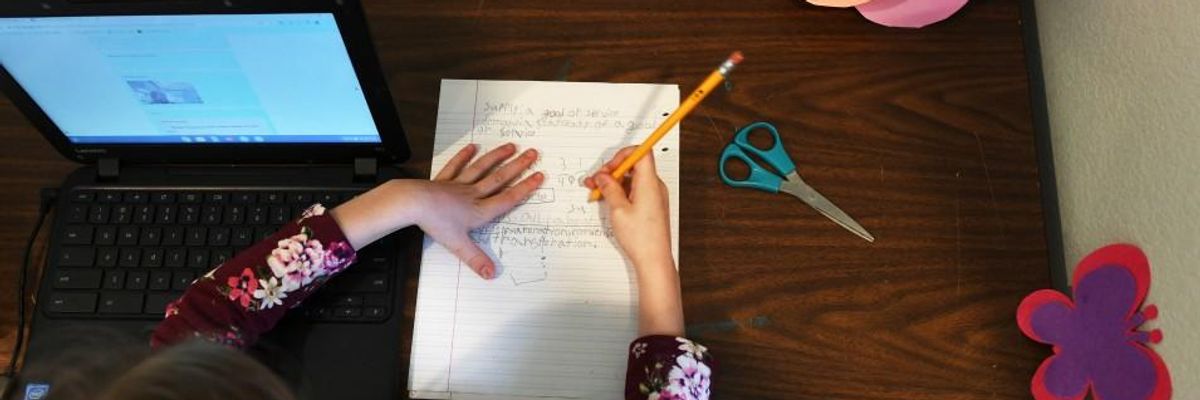dministrators and state leaders are taking surveys, analyzing data, and coming up with a myriad of options for back-to-school plans this fall. And the clock is ticking.
But why aren't they spending more time listening to the people who know what's best for students? Our teachers are the ones who work on the front lines and know our youth better than anyone else, and our students are the ones who have the most to gain or lose. Students and educators must be included in this decision--beyond just filling out surveys. They are, after all, the ones being asked to put their lives on the line.
While we are worrying about preventing the spread of COVID-19, we must also consider the social and emotional effects that a hybrid or in-person structure will have on students and educators.
Leaders should not be making back-to-school decisions as a way to please politicians and cave to social pressure; they need to listen to our educators, staff members, and students. President Donald Trump and Secretary of Education Betsy DeVos have declared that schools should open up full time this fall, even though the Centers for Disease Control and Prevention has warned that "children meeting in groups could greatly increase the spread of the coronavirus." The Trump Administration is choosing to ignore this advice and pushing to reopen schools anyway.
When COVID-19 hit the United States last spring, there was very little time for teachers to pivot to an online teaching system. And some educators were told they could not use virtual resources because not all students had equal access. There has been ongoing concern that virtual learning will increase the educational equity gap, and it has. Students across the United States have been given drastically different online learning experiences based on accessibility to technology, instructional strategies, and other factors.
State leaders and school administrators across the nation should look to cities like Atlanta, San Diego, and Los Angeles which have already made the decision to only offer online schooling in the fall.
Leaders and educators should focus on how to effectively provide online instruction this fall; just because it hasn't happened yet does not mean it isn't possible.
Unlike last spring, schools have more time before the fall semester begins to partner with organizations and businesses to create equitable access to technology. School administrators can use professional development funds to hire online teaching experts. They can use "curriculum writing" funds to pay the teachers who are creating engaging online lessons and curriculum.
School districts can also develop safe home visits to check in on students, and they can pay attention to students' social emotional needs by creating more options for non-academic, virtual social meet-ups.
Social workers can help teachers reach out to reluctant and/or absent learners, and help students get their other needs met in order to increase their chances of getting into their "learning brains."
And students, who have had a bit of a break from school, can hopefully come back with renewed focus to teach their teachers about what they need to be successful.
Administrators have been directed to split their efforts into creating three possible options for school this fall: in-person, virtual, or a hybrid of the two. Instead, they should be collaborating with teachers and students to create one plan--online learning for at least the first few months of the semester.
While we are worrying about preventing the spread of COVID-19, we must also consider the social and emotional effects that a hybrid or in-person structure will have on students and educators. Going back to school has the potential to cause educational trauma for students, teachers, and staff members. Getting sick, watching others get sick, and/or bringing COVID-19 back home to their families and communities will cause intense pain and suffering.
This decision is also an opportunity to increase intersectional equity. Since our students and educators have unique intersecting identities, we should be more aware of how this decision will affect different individuals based on their race, ethnicity, religion, mental health status, ability, sexual orientation, gender, physical health concerns, and/or any other identities that are impacted by privilege and oppression.
If schools don't resume in person this fall, there are other options; they can start later in the year with in-person or hybrid models. We should wait until returning to school is safe for all of our educators and students--both emotionally and physically. Our country is not even close to being safe from infection yet, and since restaurants, stores, and other businesses are closing down again or increasing their physical distancing rules, it does not make sense to put students and educators in enclosed, indoor spaces at this time.
People are grieving the loss of their loved ones, their incomes, or just plain normalcy. As this virus is disproportionately affecting some communities more than others, we need to create a new "normal." And though much is unknown about COVID-19, we could use this pandemic as an opportunity to increase educational equity in ways that we have failed before.
